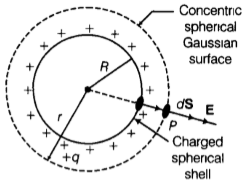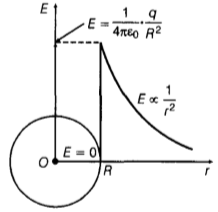Apply gauss law to show that …

CBSE, JEE, NEET, CUET
Question Bank, Mock Tests, Exam Papers
NCERT Solutions, Sample Papers, Notes, Videos
Related Questions
Posted by Anterpreet Kaur 1 year, 3 months ago
- 0 answers
Posted by Aniket Mahajan 7 months, 2 weeks ago
- 0 answers
Posted by Khushbu Otti 1 year, 2 months ago
- 0 answers

myCBSEguide
Trusted by 1 Crore+ Students

Test Generator
Create papers online. It's FREE.

CUET Mock Tests
75,000+ questions to practice only on myCBSEguide app
 myCBSEguide
myCBSEguide

Sia ? 6 years, 4 months ago
Electric Field of Point Charge. The electric field of a point charge Q can be obtained by a straightforward application of Gauss' law. Considering a Gaussian surface in the form of a sphere at radius r, the electric field has the same magnitude at every point of the sphere and is directed outward. Let us consider charge +q be uniformly distributed over a spherical shell of radius R. Let E is to be obtained at Plying outside of spherical shell.


{tex}\because {/tex} 'E' at any point is radially outward (if charge q is positive) and has same magnitude at all points which lie at the same distance r from centre of spherical shell such that r > R.
Therefore, Gaussian surface is concentric sphere of radius r such that r > R.
By Gauss' theorem
{tex}\oint \mathbf { E } \cdot d \mathbf { S } = \frac { q } { \varepsilon _ { 0 } } \Rightarrow \oint E d S \cos 0 ^ { \circ } = \frac { q } { \varepsilon _ { 0 } }{/tex}
[{tex}\because {/tex} E and dS are along the same direction]
{tex}E \cdot \oint d S = \frac { q } { \varepsilon _ { 0 } }{/tex} [{tex}\because {/tex} Magnitude of E is same at every point on Gaussian surface]
{tex}E \times 4 \pi r ^ { 2 } = \frac { q } { \varepsilon _ { 0 } }{/tex}
{tex}\Rightarrow \quad E = \frac { 1 } { 4 \pi \varepsilon _ { 0 } } \cdot \frac { q } { r ^ { 2 } }{/tex}
Now, graph
Variation of E with r for a spherical shell in which charge q is distributed over its surface which shows that electric field inside a spherical shell is zero.
0Thank You